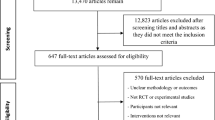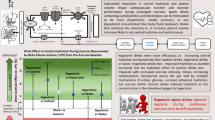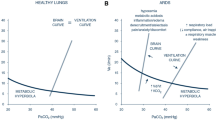Abstract
Oxygen toxicity is a problem in diving which can have fatal consequences in the water. When divers use closed-circuit oxygen rebreathing apparatus they are taking only oxygen 100% and this hyperoxic exposure increases the generation of reactive oxygen species (ROS) in biological tissues. The objective of the present study is to evaluate the effects of hyperoxia on biomarkers of oxidative stress in closed-circuit oxygen military divers. Fifteen professional divers of Spanish Navy Diving Center participated in a training program which consisted of one-hour immersion at seven metres of depth breathing oxygen 100% with closed-circuit oxygen rebreathing apparatus. The training went on two or three times per week for the first six weeks and once a week for the last six weeks. Serum total antioxidant status (TAS), levels of glutathione peroxidase (GPx), nitrates (NO3 −) and urinary concentrations of 15-isoprostane F2t were measured. The results show that TAS decreased significantly after 6 weeks (mean 1.38 versus 1.23 mmol/l), with a slight increase at the end (mean 1.31 mmol/l). GPx and F2-isoprostanes were significantly lower after 6 and 12 weeks and NO3 − was significantly lower after 6 weeks and remained unchanged until the end. In summary, professional divers who use closed-circuit apparatus and therefore breathe oxygen 100%, do not suffer an important oxidative hyperoxia-induced stress, probably due an adaptive process after hyperoxia. The age and good physical form of the subjects studied could probably enhance the adaptive process to hyperoxia.
Resumen
La toxicidad del O2 es un problema en el buceo que puede tener consecuencias fatales en el agua. Los buceadores que utilizan equipos de circuito cerrado respiran oxígeno al 100% y esta exposición hiperóxica aumenta la producción de especies reactivas de oxígeno (ROS) en los tejidos biológicos. El objetivo del presente trabajo es evaluar el efecto, de la hiperoxia sobre biomarcadores de daño oxidativo en un grupo de buceadores profesionales. Quince buceadores profesionales del Centro de Buceo de la Armada Española participaron en un programa de entrenamiento de una hora de inmersión diaria a siete metros de profundidad respirando oxígeno puro con equipos de circuito cerrado. El programa tenía lugar dos o tres veces por semana durante las seis primeras semanas y una vez por semana durante las últimas seis semanas. Se midieron niveles séricos del estado antioxidante total (TAS), glutation peroxidasa (GPx), así como de nitratos (NO3 − y la concentración urinaria del 15-isoprostano F2t. Los resultados muestran que TAS descendió significativamente (desde un valor medio 1,38 a 1,23 mmol/l), después de 6 semanas con un leve incremento al final (1,31 mmol/l). Los niveles de GPxy los isoprostanos fueron significativamente más bajos después de 6 y 12 semanas y el NO3 − disminuyó después de 6 semanas, manteniéndose invariable hasta el final. En resumen, los buceadores profesionales que utilizan equipos de circuito cerrado y por tanto respiran oxígeno 100%, no sufren un importante daño oxidativo inducido por la hiperoxia, probablemente porque tenga lugar un proceso adaptativo, facilitado por la juventud y buena forma física de todos los sujetos estudiados.
Similar content being viewed by others
References
Aguilo, A., Tauler, P., Fuentespina, E., Tur, J.A., Cordova, A., Pons, A. (2005): Antioxidant response to oxidative stress induced by exhaustive exercise. Physiol Behav, 84, 1–7.
Arieli, R., Shochat, T., Adir Y. (2006): CNS toxicity in closed-circuit oxygen diving: symptoms reported from 2527 dives. Aviat Space Environ Med, 77, 526–532.
Arkovitz, M.S., Szabó, C., Garcia, V.F., Wong, H.R., Wispe, J.R. (1997): Differential effects of hyperoxia on the inducible and constitutive isoforms of nitric oxide synthase in the lung. Shock May, 7(5), 345–350.
Banfi, G., Malavazos, A., Iorio, E., Dolci, A., Doneda L., Verna, R., Corsi, M.M. (2006): Plasma oxidative stress biomarkers, nitric oxide and heat shock protein 70 in trained elite soccer players. Eur J Appl Physiol, 96, 483–486.
Cao, G., Prior, R.L. (1998): Comparison of different analytical methods for assessing total antioxidant capacity of human serum. Clin Chem, 44, 1309–1315.
Hirokazu, T. (2007): Biomarkers for oxidative stress: clinical application in pediatric medicine. Current Medicinal Chemistry, 14, 339–351.
Felaco, M., Grilli, A., Gorbunoy, N., Di Napoli, P., De Lutiis, M.A., Di Giulio, C., Taccardi, A.A., Barsotti, A., Barbacane, R.C., Reale, M., Conti, P. (2000): Endothelial NOS expression and ischemia-reperfusion in isolated working rat heart from hyperoxic conditions. Biochim Biophys Acta Dec, 15, 1524(2–3), 203–211.
Ferrer, M.D., Sureda, A., Batle, J.M., Tauler, P., Tur, J.A., Pons, A. (2007): Scuba diving enhances endogenous antioxidant defenses in lymphocytes and neutrophils. Free Radic Res, 41, 274–281.
Galassetti, P.R., Nemet, D., Pescatello, A., Rose-Gottron, C., Larson, J., Cooper, D.M. (2006): Exercise, caloric restriction, and systemic oxidative stress. J. Investig Med, 54, 67–75.
Kot, J. (2003): Oxidative stress during oxygen tolerance test. Int Marit Health, 54, 117–26.
Lemaitre, F., Meunier, N., Bedu, M. (2002): Effect of air diving exposure generally encountered by recreational divers: oxidative stress? Undersea Hyperb Med, 29, 39–49.
Lundberg, J.O., Weitzberg, E., Cole, J.A., Benjamin, N. (2004): Nitrate, bacteria and human health. Nat Rev Microbiol, 2, 593–602.
Margaritis, I., Palazzetti, S., Rousseau, A.S., Richard, M.J., Favier, A. (2003): Antioxidant supplementation and tapering exercise improve exercise-induced antioxidant response. J Am Coll Nutr, 22, 147–156.
Muijsers, R.B.R., Folkerts, G., Henricks, P.A.J., Sadeghi-Hasgjin, G., Nijkamp, F.P. (1997): Peroxynitrite: a two faced metabolite of nitric oxide. Life Sci, 60, 1833–1845.
Murphy, M.P. (1999): Nitric Oxide and cell death. Biochim, Biophys Acta, 1411, 401–414.
Noiri, E., Tsukahara, H (2005): Parameters for measurement of oxidative stress in diabetes mellitus: applicability of enzyme-linked immunosorbent assay for clinical evaluation. J Invest Med, 53, 167–175.
Palazzetti, S., Richard, M.J., Favier, A., Margaritis, I. (2003): Overloaded training increases exercise-induced oxidative stress and damage. Can J Appl Physiol, 28, 588–604.
Phillips, M., Cataneo, R.N., Greenberg, J., Grodman, R., Gunawardena, R., Naidu, A. (2003): Effects of oxygen on breath markers of oxidative stress. Eur Respir J 21, 48–51.
Powers, S.K., Hamilton, K. (1999): Antioxidants and exercise. Clin Sports Med, 18, 525–536.
Pryor, W.A., Squadrito, G.L. (1995): The chemistry of peroxynitrite: a product from the reaction of nitric oxide with superoxide. Am J Physiol Lung Cell Mol Physiol, 268, L699-L722.
Ricciardolo, F.L.M., Sterk, P.J., Gastón, B., Folkerts, G. (2004): Nitric oxide in health and disease of the respiratory system. Physiol Rev, 84, 731–765.
Sureda, A., Batle, J.M., Tauler, P., Aguiló, A., Cases, N., Tur, J.A., Pons, A. (2004): Hypoxia/reoxygenation and vitamin C intake influence NO synthesis and antioxidant defenses of neutrophils. Free Radic Biol Med, 37, 1744–1755.
Tozzi-Ciancarelli, M.G., Penco, M., Di Massimo, C. (2002): Influence of acute exercise on human platelet responsiveness: possible involvement of exercise-induced oxidative stress. Eur J Appl Physiol, 86, 266–72.
Watson, T.A., MacDonald-Wicks, L.K., Garg, M.L. (2005): Oxidative stress and antioxidants in athletes undertaking regular exercise training. Int J Sport Nutr Exerc Metab, 15, 131–146.
Zhang, J., Sam, A.D., Klitzman, B., Piantadosi, C.A. (1995): Inhibition of nitric oxide synthase on brain oxygenation in anesthetized rats exposed to hyperbaric oxygen. Undersea Hyperb Med, 22(4), 377–382.
Author information
Authors and Affiliations
Corresponding author
Additional information
In memoriam of Prof. Dr. D. Fernando SÁNCHEZ GASCÓN.
Rights and permissions
About this article
Cite this article
Alcaraz-García, M.J., Albaladejo, M.D., Acevedo, C. et al. Effects of hyperoxia on biomarkers of oxidative stress in closed-circuit oxygen military divers. J. Physiol. Biochem. 64, 135–141 (2008). https://doi.org/10.1007/BF03168241
Received:
Issue Date:
DOI: https://doi.org/10.1007/BF03168241
Key words
- Reactive oxygen metabolites, (ROS)
- Total antioxidant status (TAS)
- Glutathione peroxidase (GPx)
- Hyperoxia
- Nitrate




